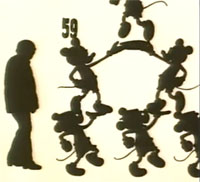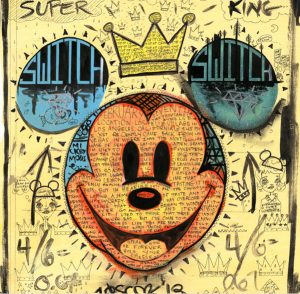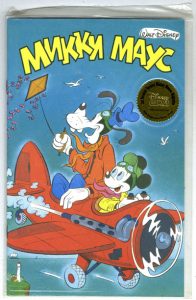Suspended Animation #374
Over the decades, there have been animated shorts that featured Mickey Mouse but were not produced by the Walt Disney Company.
Uncle Walt begins with pictures of Walt Disney at various ages followed by a pan across a graveyard showing the graves of hundreds of Perri’s (Disney produced in 1957 a live action fantasy about the life of squirrels titled Perri), then there are scenes with very early-style Mickey and Minnie Mouse with racial caricatures and outhouse gags, a Fantasia sequence including the female centaurettes working a red light district with Goofy as a pimp, a scene of frightened little rabbit children looking at scenes from Disney cartoons like the transformation of the queen into the old hag in Snow White, and a scene of the Seven Dwarfs gathering to worship Mickey Mouse in a “Mouse-ka-mausoleum” reminiscent of a similar scene in Snow White.
The short was an independent film made in 1964 by Bob Swarthe who started working on the film while he was in high school and was part of the UCLA Animation Workshop. Swarthe went on to greater success as a professional animator, even being nominated for an Academy Award for his work on Star Trek – The Motion Picture.
Mickey Mouse in Vietnam (aka Short Subject) is a 16mm underground short political cartoon that lasts a little over a minute. The director was Lee Savage who also was responsible for the animation. It features Mickey Mouse being shipped to Vietnam during the war and shot dead moments after arriving. It was produced independently sometime between 1968 and 1970.
Savage later did animated segments for Sesame Street and The Electric Company.
Both these short films occasionally popped up at film festivals but Disney never acknowledged them in the belief that by not giving them any attention or publicity, it would result in them fading away.
In 1988 for Mickey Mouse’s 60th birthday, a Disney animation festival sponsored by a Soviet commission on cinematography was kicked off with a gala premiere in Moscow. It was the first time Disney shorts and feature films, except for Snow White and the Seven Dwarfs (1937), had officially and legally been viewed in the USSR.
For the festival, tickets were sold out weeks in advance. However, the Walt Disney Company requested that children from local orphanages be invited free of charge to screenings in Moscow, Leningrad and Tallinn. In Leningrad, Mickey visited the world-famous Soviet circus, where he was invited onstage as a guest of honor.
Roy E. Disney who was then Vice President of the Walt Disney Company and very involved with the revival of Disney animation said, “This festival came about originally because the Soviets came to us and asked if we would be interested in bringing some of our films there. It’s the beginning of a new era. It’s much bigger than just Disney and Mickey Mouse coming to the Soviet Union. It is two countries coming closer together. And it’s very exciting.”
Audiences had the opportunity to see 101 Dalmatians, Bambi, Snow White and Fantasia along with vintage short cartoons featuring Mickey Mouse and Donald Duck.
The Russian audience was familiar with the character but couldn’t understand English so Soviet actors were hired to simultaneously read translated scripts during the screening, after being coached on the characters and various voice inflections.
By the way, the first Russian version of a Mickey Mouse comic book (32 pages) was released May 16, 1991 in a printing of 200,000 copies and all of them were sold out within hours of its release.
A costumed Mickey Mouse joined a costumed Misha the Bear, the mascot for the 1980 Moscow Olympics, for a tour of Red Square. While in Moscow, Mickey also visited Gorky Park, Arbat Square, and the Embassy School.
The Disney Channel filmed a half hour documentary narrated by Willard Scott about the event entitled Mickey Goes to Moscow that originally aired on the channel on January 24th, 1989.
There were many parents and children in Red Square but their reaction to Mickey was more respectful than affectionate.
“The people were very leery at first,” said Suzanne Stevens, Director of Production for the Disney Channel special. “You can’t peel American kids off Mickey. But the Russian kids would just wave from a distance. We’d urge them to come up to Mickey Mouse. Once they saw Misha, however, they gathered around, laughing. They were all so excited!
“I’d give a child a pair of mouse ears. They’d take them. Their face would light up as they tried them on and then they would give them back. They’re not used to people giving them things. For Russian children the happy experience of wearing the ears for only a moment was enough.”
 Roy E. Disney and other Disney executives visited the famed animation studio, Soyuzmultfilm Studios. “Some of their animation is done very much like ours,” said Disney. “Though some of their technology is primitive, their creativity makes up for it and their work is really quite good.”
Roy E. Disney and other Disney executives visited the famed animation studio, Soyuzmultfilm Studios. “Some of their animation is done very much like ours,” said Disney. “Though some of their technology is primitive, their creativity makes up for it and their work is really quite good.”
A special three minute cartoon was presented to Roy E. Disney titled The Marathon. The cartoon was shot for five months and, due to the fact that many animators worked on enthusiasm alone on the project, it cost only 300 Soviet rubles.
The cartoon shows a young boy in black silhouette going to a line that divides the screen image in half. It is like a mirror with the young boy on one side and the classic black and white Mickey Mouse in black silhouette on the other side.
At the top of the screen is the number 1928, the year Mickey debuted. The number clicks to a zero and starts clicking upwards to the number 60. During this time, the young boy ages into a young man and finally an old, tired, overweight man.
During the short, Mickey and the other character have fun dancing and playing until the ravages of age slows down the old man. Mickey whistles to call over a chair for the man to sit on.
Another young boy runs up to the man and is directed back to the line where the number clicks back to zero and the assumption is that the same adventure will be repeated again with this new boy and an ageless Mickey.
While most people assume the aging man is Walt Disney, supposedly it is actually meant to represent co-director and writer Tumelya.
The short was co-directed by Mikhail Tumelya and Alexander Petrov and was written by Tumelya, who animated on the short, as well. Animator Sasha Dorogov who animated on this short later worked at Disney Feature Animation in Florida and did some animation in Pocahontas, Mulan, and Lilo & Stitch.
The very catchy music was by A. Varlahov Lilivokalany. D. Murkis, B. Bresler, Sasha Zuzkevich and Polene Tumelya were used as dancer reference.
It was produced by I. Boyarsky and A. Zalessky at The School for Advanced Studies for Screen Writers and Directors Belarusfilm, with Soyuzmultfilm Studios in Moscow.
“It was an absolutely beautiful tribute to Mickey. We were all choked up. My wife was in tears,” said Roy E. Disney. Really, quite literally, we all wound up hugging each other with tears coming down our faces…it was one of the most emotional moments that I can remember in my life.
“Everyone loved Mickey in Russia and this trip gave me a sense that history was happening right before my eyes. It’s a spectacular gesture of the world shrinking.”




 Jim Korkis is an internationally respected animation historian who in recent years has devoted his attention to the many worlds of Disney. He was a columnist for a variety of animation magazines. With his former writing partner, John Cawley, he authored several animation related books including The Encyclopedia of Cartoon Superstars, How to Create Animation, Cartoon Confidential and Get Animated’s Animation Art Buyer’s Guide. He taught animation classes at the Disney Institute in Florida as well as instructing classes on acting and animation history for Disney Feature Animation: Florida.
Jim Korkis is an internationally respected animation historian who in recent years has devoted his attention to the many worlds of Disney. He was a columnist for a variety of animation magazines. With his former writing partner, John Cawley, he authored several animation related books including The Encyclopedia of Cartoon Superstars, How to Create Animation, Cartoon Confidential and Get Animated’s Animation Art Buyer’s Guide. He taught animation classes at the Disney Institute in Florida as well as instructing classes on acting and animation history for Disney Feature Animation: Florida.




















































The music credits for “Marathon” are a little dishonest. “Lilivokalany” is a transliteration, by way of Cyrillic, of Queen Liliuokalani, who is credited with writing the song “Aloha Oe”, heard at the beginning and end of the film. The “very catchy music” that plays in the middle is “Mama Inez”, a rumba by the Cuban composer Eliseo Grenet, which was a big hit in the 1930s; it is also played in the Flip the Frog cartoon “Soda Squirt”. Alexander Varlamov was a 19th-century Russian composer, but none of his music is played in “Marathon”. If there’s a joke in there, I don’t get it.
The comic march used in “Mickey Mouse in Vietnam” was later featured prominently in the horror film “Dawn of the Dead”, when the zombies are shambling around the shopping mall. I always assumed it had been composed specifically for that film, but apparently not.
Another animated short with an unauthorised appearance by Mickey Mouse is “Nimbus Libere”, a propaganda cartoon put out by the Vichy government of Nazi-occupied France in 1944. The American military is represented by Mickey Mouse, Donald Duck, Goofy, Popeye the sailor and Felix the cat, who bomb French cartoon character Professor Nimbus and his family to smithereens.
I remember seeing “Uncle Walt” as part of a program of shorts at UCSC. A former Disney animator — Bob Carlson, I think — spoke to a class afterwards. He laughed when asked about the short, and expressed the suspicion it was done by somebody specific inside Disney. He declined to elaborate.
Very good post, Jim. I noticed some Ward Kimball swipes from his Mickey dance in “Mickey’s Birthday Party” in “The Marathon”. Mickey holds his pants out a bit and scoots forward on his toes, going towards his cane in Ward’s animation.
I got in a little trouble over my senior film at Chouinard in 1970. It was called “Mike Mouse in ‘City Life'”, and featured my version of Mickey and Minnie in an adventure with a giant frog mermaid in the underground city sewers of “Anytown”. Roy O. Disney hated my cartoon and at first asked that it be removed from the student film festival at the Disney theater on the lot. After some negotiation with the faculty, they opted to present my cartoon last on the program, at the end of a FOUR HOUR show. I think there were about three people in the auditorium at that point. So my film was seen by few people. It is not on the Internet, and never will be. One print of “City Life” is in private hands, not to my great delight.
I actually first heard about “Mickey Mouse in Vietnam”, suprisingly, in the officiallly liscensed book ” Encyclopedia of Walt Disney’s Animated Characters” (1987,1993, 1998). How that got through Disney’s legal depatment, is anyone’s guess.
Mickey Mouse in Vietnam is a classic. It seems real, especially since the Plane Crazy/Steamboat Willie/Barnyard Dance era was pretty violent and crazy anyway.